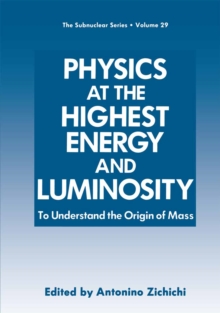
New Phenomena in Subnuclear Physics : Part A PDF
by Antonino Zichichi
Part of the The Subnuclear Series series
Description
In July 1975 a group of 122 physicists from 68 laboratories of 27 countries met in Erice to attend the 13th Course of the International School of Subnuc1ear Physics.
The countries represented at the School were: Australia, Austria, Belgium, Brazil, Canada, Chile, Denmark, France, Germany, Greece, India, Iran, Israel, Italy, Japan, Mexico, The Netherlands, Norway, Poland, Portugal, Spain, Sweden, Switzerland, Turkey, The United Kingdom, The United States of America and Yugoslavia.
The School was sponsored by the Italian Ministry of Public Education (MPI), the Italian Ministry of Scientific and Technolog- ical Research (MRST) , the North Atlantic Treaty Organization (NATO), the Regional Sicilian Government (ERS) and the Weizmann Institute of Science.
The School was one of the most exciting, due to the impressive number of discoveries made not only in the field of the new par- ticles by the MIT-BNL (reported by S.
C. C. Ting) and by the SLAC- SPEAR (reported by M. Breidenbach) Groups, but also in the field of high energy neutrino interactions where Carlo Rubbia observes ~- pairs, together with bumps in the total energy of the hadronic system at Wh~4 GeV and a discontinuity in the at Ev~50 GeV plus a bump at Wmin~4 GeV; all these phenomena being possibly connected.
To this remarkable amount of new and exciting results it has to be added the great discovery of DORIS (reported by B.
Wiik) on the first example of a new particle Pc: the highlight of the Course.
Information
-
Download - Immediately Available
- Format:PDF
- Publisher:Springer US
- Publication Date:13/03/2013
- Category:
- ISBN:9781461342083
Other Formats
- Paperback / softback from £75.39
Information
-
Download - Immediately Available
- Format:PDF
- Publisher:Springer US
- Publication Date:13/03/2013
- Category:
- ISBN:9781461342083










